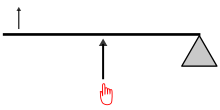Lever
Theory of operation
K-wings suck
Archimedes was the first to explain the principle of the lever, stating:
"(equal) weights at equal distances are in equilibrium, and equal weights at unequal distances are not in equilibrium but incline towards the weight which is at the greater distance."
Archimedes once famously remarked: "Πα βω και χαριστιωνι ταν γαν κινησω πασαν." ("Give me a place to stand and with a lever I will move the whole world.")
The point where you apply the force is called the effort. The effect of applying this force is called the load. The load arm and the effort arm are the names given to the distances from the fulcrum to the load and effort, respectively. Using these definitions, the Law of the Lever is:
- Load arm X load force = effort arm X effort force. When 2 things are balanced, when a 1 gram feather for instance is balanced by a one kilogram rock on a lever the feather would go up and the rock would go down, but if a 1 kilogram rock was balanced by a 1 kilogram rock, the lever would be in the middle.
The three classes of levers
There are three classes of levers which represent variations in the location of the fulcrum and the input and output forces.
First-class levers

A first-class lever is a lever in which the fulcrum is located between the input effort and the output load. In operation, a force is applied (by pulling or pushing) to a section of the bar, which causes the lever to swing about the fulcrum, overcoming the resistance force on the opposite side. The fulcrum may be at the center point of the lever as in a seesaw or at any point between the input and output. This supports the effort arm and the load.
Examples:
- Beam engine although here the aim is just to change the direction in which the applied force acts, since the fulcrum is normally in the centre of the beam (i.e. D1 = D2)
- Bicycle hand brakes
- Can opener and bottle opener
- Crowbar
- Curb bit
- Hammer, when pulling a nail with the hammer's claw
- Hand trucks are L-shaped but work on the same principle, with the axis as a fulcrum
- Oars
- Pliers (double lever)
- Scissors (double lever)
- Seesaw (also known as a teeter-totter)
- Shoehorn
- Spud bar (moving heavy objects)
- Trebuchet, an upside down example of the above picture
- Wheel and axle because the wheel's motions follows the fulcrum, load arm, and effort arm principle
Second-class levers

In a second class lever the input effort is located at one end of the bar and the fulcrum is located at the other end of the bar, opposite to the input, with the output load at a point between these two forces. Examples:
- Crowbar
- Dental elevator
- Door
- Nutcracker
- Paddle
- Springboard (diving board)
- Wheelbarrow
- Wrench
Third-class levers

For this class of levers, the input effort is higher than the output load, which is different from second-class levers and some first-class levers. However, the distance moved by the resistance (load) is greater than the distance moved by the effort. Since this motion occurs in the same length of time, the resistance necessarily moves faster than the effort. Thus, a third-class lever still has its uses in making certain tasks easier to do. In third class levers, effort is applied between the output load on one end and the fulcrum on the opposite end.
Examples:
- Arm
- Baseball bat
- Boat paddle
- Broom
- Door
- Fishing rod
- Hockey stick
- Tongs
- Tweezers
- Mandible
- Mousetrap
- Nail clippers, the main body handle exerts the incoming force
- Shovel (the action of picking or lifting up sand or dirt)
- Sling
- Tools, such as a hoe or scythe
- Stapler
Mnemonic
A mnemonic for remembering the three classes of levers is the word flex, where the letters f-l-e represent the fulcrum, the load, and the effort as being between the other two, in the first-class lever, the second-class lever, and the third-class lever respectively. (To relate the mnemonic to the above diagrams, note that: the "fulcrum" is represented by the triangle, the "effort" is denoted by the arrow with a hand symbol, and the "load" is the other arrow.) To remember what the different classes of levers look like, another mnemonic is "fre 123" In a 1st class lever the fulcrum is in the middle, 2nd class the resistance is in the middle, and 3rd class the effort is in the middle of it. Alternatively, the term 'Frogs lay eggs' can also be used in the similar manner. Some people remember the word 'elf', which sorts the classes from the third to first. Another way is "FREE Lever" Which means Fulcrum + Resistance + Effort Equals Lever.
See also
External links
- Lever at Diracdelta science and engineering encyclopedia
- A Simple Lever by Stephen Wolfram, The Wolfram Demonstrations Project.
- Levers: Simple Machines at EnchantedLearning.com
